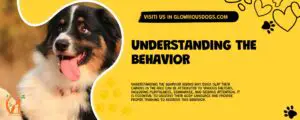Your dog may slap you in the face as a sign of dominance or attention-seeking behavior. We will explore why dogs engage in this behavior and how to address it effectively.
Understanding the motivation behind your dog’s actions can help you strengthen your bond and promote positive behaviors. Additionally, we will discuss possible solutions and training techniques to discourage this behavior, ensuring a harmonious and respectful relationship with your furry friend.
By implementing these proven strategies, you can create a peaceful and well-behaved environment for both you and your dog.
Understanding The Behavior
Understanding the behavior behind why dogs slap their owners in the face can be attributed to various factors, including playfulness, dominance, and seeking attention. It is essential to observe their body language and provide proper training to address this behavior.
What does it mean when dogs slap their owners?
Dogs slapping their owners’ faces is a behavior that can be both puzzling and concerning. There could be several reasons behind this behavior, which can vary depending on the individual dog. It is essential to observe their body language and consider other factors to determine the meaning behind this action. Slapping can be a form of communication for dogs, expressing a range of emotions including excitement, playfulness, or even frustration.
Some possible explanations for why a dog might slap their owner include:
| Possible Reasons |
|---|
| The dog wants attention or is seeking playtime. |
| It could be a submissive gesture to show respect or submission. |
| It may indicate that the dog is feeling anxious or stressed. |
Overall, understanding why a dog slaps their owner requires a careful assessment of the dog’s behavior, context, and body language. It is essential to ensure the well-being and happiness of both the dog and the owner by addressing any underlying issues and seeking professional advice if needed.
Instinctual Factors
The tendency for dogs to slap their owners in the face can often be attributed to instinctual factors rooted in their pack hierarchy. Dominance and submission play a crucial role in this behavior. Dogs are naturally driven by a pack mentality, where establishing a hierarchy is essential for survival and stability.
When it comes to dominance, some dogs may perceive their owners as equals, and slapping serves as a way to assert their authority. On the other hand, submissive dogs may slap their owners to demonstrate their subservience and show respect.
Furthermore, ancestral instincts deeply influence a dog’s behavior. Dogs are descendants of wolves, who had strict hierarchies within their packs. The act of slapping may be a remnant of their ancestral instincts, where physical contact was used as a means of establishing dominance or submission within the pack.
Social Interaction And Play
During playtime, some dogs may exhibit a behavior of slapping their owners in the face. This behavior is often a form of social interaction and play. Dogs, being natural pack animals, use various forms of communication to engage with each other and establish dominance or boundaries. Slapping can be seen as a playful gesture aimed at initiating interaction or gauging the owner’s response.
It is important to differentiate between friendly and aggressive slapping. Friendly slapping is generally accompanied by a wagging tail, relaxed body language, and a playful demeanor. On the other hand, aggressive slapping may be accompanied by growling, raised hackles, and a tense body posture.
Understanding the connection between slapping and playfulness can help owners develop a better understanding of their dog’s communication and behavior. If the slapping becomes concerning or aggressive, it is recommended to consult a professional dog trainer or behaviorist to address the underlying causes and resolve any potential issues.
Attention-seeking Behavior
When it comes to understanding why dogs slap their owners in the face, attention-seeking behavior is often the underlying cause. Dogs are social animals and they thrive on human attention. Slapping can become one way for them to seek attention from their owners. It is important to recognize that dogs may not have learned alternative behaviors to gain attention, leading them to display this behavior.
To address this issue, it is crucial to provide your dog with alternative methods to seek attention. One effective approach is to reinforce positive behaviors such as sitting or offering a paw. By rewarding these actions, your dog will learn that engaging in more appropriate and gentle behaviors leads to attention from you.
| Possible solutions and alternative behaviors |
|---|
| 1. Teach and reinforce positive behaviors like sitting or offering a paw |
| 2. Engage your dog in mentally stimulating activities such as puzzle toys or obedience training |
| 3. Establish a regular exercise routine to provide physical and mental stimulation for your dog |
| 4. Consider consulting with a professional dog trainer or behaviorist for additional guidance and support |
By providing alternative ways for your dog to seek attention, such as reinforcing positive behaviors and engaging in mentally stimulating activities, you can help redirect their slapping behavior. Remember, consistent training and positive reinforcement are key to modifying any unwanted behavior and fostering a healthier bond with your furry friend.
Tapping Into Learned Behavior
Understanding why your dog slaps you in the face requires tapping into their learned behavior and how they learn through positive reinforcement. Dogs, like humans, learn through association and consequences. If your dog has learned that slapping you in the face leads to attention or rewards, they may continue this behavior.
It’s important to address inadvertent reinforcement from owners. If you react strongly or provide attention when your dog slaps you, they may view it as a positive interaction. By unintentionally reinforcing the behavior, you inadvertently teach your dog that slapping in the face is acceptable.
To correct this behavior, focus on redirecting your dog’s attention to more appropriate behaviors and rewarding them for those actions. Consistency is key in retraining your dog to understand that slapping is not acceptable and that positive behaviors are rewarded. Seek guidance from a professional dog trainer if needed.
Sensory Stimulation
Wondering why your furry friend slaps you in the face? One possible reason is sensory stimulation. Dogs have sensitive noses and paws, so they may resort to slapping as a way to interact or communicate with you. Keep an eye out for other signs of affection or playfulness!
| Subheading | Content |
|---|---|
| How dogs use their paws to interact with the environment | When dogs slap you in the face, it could be a form of tactile exploration. Dogs use their paws to gather sensory information from their surroundings, and your face happens to be a highly accessible area. Through slapping or pawing, dogs can assess different textures, temperatures, and even the presence of scents. It serves as a way for them to investigate and gather information about their environment. Furthermore, face slapping could also indicate a sensory-related motive. Dogs have a heightened sense of smell, so they may be trying to gather specific information from your face, such as your emotional state or any lingering scents. While it may seem unconventional to us, face slapping is a natural behavior for dogs to explore and interact with their world. |
Physical Discomfort And Health Issues
If your dog is slapping you in the face, it could be a sign of physical discomfort or underlying health issues. Dogs might exhibit this behavior as a way to communicate their pain or discomfort to their owners.
Identifying possible health conditions can help determine the cause of the slapping behavior. Some common health issues include ear infections, dental problems, eye irritation, or skin allergies. Observing other symptoms like excessive scratching, redness, discharge, or behavioral changes can provide further insights into potential health concerns.
Consulting with a veterinarian is crucial in addressing these issues. A medical evaluation can help identify and treat any underlying health conditions that may be causing your dog to slap you in the face.
Communicating Anxiety Or Fear
If your dog slaps you in the face, it could be a sign of anxiety or fear. Dogs may resort to this behavior to communicate their discomfort or unease in certain situations. Understanding their body language and providing a safe and calm environment can help alleviate their stress.
| Recognizing signs of anxiety and fear in dogs |
|---|
| Understanding facial slapping as a coping mechanism |
| Intervention strategies for fearful or anxious dogs |
Signs of anxiety and fear in dogs can often be observed through their body language and behavior. Pay attention to excessive panting, trembling, pacing, restlessness, or avoidance of certain situations. Dogs may also display aggression, such as growling or barking, when they feel anxious or fearful.
Facial slapping is a behavior dogs may exhibit in response to anxiety or fear. It can be a way for them to cope with their emotions or communicate their discomfort. Dogs may slap their owners’ faces as a way to signal their distress or seek comfort.
To help a fearful or anxious dog, it is important to address the underlying cause of their anxiety or fear. Creating a safe and predictable environment can be beneficial, as well as providing positive reinforcement and rewards for calm behavior. Consultation with a professional dog trainer or behaviorist can provide guidance on specific intervention strategies based on your dog’s individual needs.
Correcting The Behavior
Dogs slapping their owners in the face can be a frustrating behavior. However, it is essential to understand that dogs don’t engage in this behavior with malicious intent. Instead, it might be a result of various factors like excitement, dominance, or seeking attention. Addressing this behavior requires patience and consistency. Rather than resorting to punishment, positive reinforcement training techniques can be highly effective.
Redirecting your dog’s behavior is crucial. When your dog begins to slap you, immediately offer them an alternative behavior, such as sitting or giving a paw. Reward them with treats and praise for engaging in the desired action instead of slapping. Consistently redirecting their attention towards positive actions will help them understand what behaviors are more appropriate.
If the issue persists, consulting with a professional dog trainer is recommended. They can provide guidance specific to your dog’s needs and help you tailor a training program suited to address the slapping behavior. A professional trainer can also assist in assessing any underlying issues that may be contributing to your dog’s behavior and develop a comprehensive plan accordingly.
Maintaining A Healthy Human-dog Relationship
Strengthening the bond between you and your dog is essential to maintaining a healthy and fulfilling relationship. One way to build trust and understanding is through positive interactions. Rewarding your dog’s good behavior and providing praise and treats when they demonstrate positive actions establishes a sense of trust. Additionally, promoting healthy communication and mutual respect is crucial. Clear and consistent training methods help your dog understand what is expected of them, while listening and responding to their needs fosters a sense of respect and understanding on both sides. Encouraging exercise and playtime not only keeps your dog physically healthy but also deepens the bond between you and your furry friend. By investing time and effort into building a strong connection, you can minimize any slapping behavior and create a loving and harmonious relationship with your dog.
Conclusion
To sum up, if your dog slaps you in the face, there could be various reasons behind this behavior. It could be a playful gesture, an attempt to get your attention, or even a sign of dominance. Understanding your dog’s body language and providing proper training and socialization can help address this behavior.
Remember, every dog is unique, so it’s crucial to consult with a professional trainer or behaviorist for tailored advice. Happy bonding with your furry friend!
Frequently Asked Questions For Why Does My Dog Slap Me In The Face
Why Does My Dog Keep Hitting Me In The Face?
Your dog may be hitting you in the face due to playful behavior or seeking attention. It could also be a sign of dominance or a way of expressing frustration or anxiety. Observe their body language to better understand their motivation and consult a professional trainer if the behavior continues.
Why Do Dogs Hit You With Their Paw?
Dogs hit you with their paw as a form of communication, attention-seeking, or playfulness. It’s their way of getting your attention or inviting you to engage with them.
Why Does My Dog Swat His Paw At Me?
Your dog may swat his paw at you for various reasons, such as seeking attention, playfulness, or discomfort. It’s a form of communication. Observe your dog’s body language and consult a veterinarian if the behavior persists or is accompanied by other signs of distress.
Why Do Dogs Give You Their Paw Without Asking?
Dogs give you their paw to show affection and seek attention. It’s a natural behavior that they learn through positive reinforcement.












